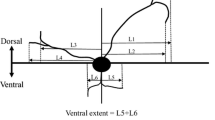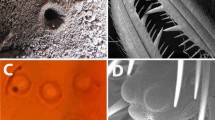Abstract
Ants of the ponerine genus Odontomachus have evolved a mechanism that allows them to instantaneously close their long mandibles to catch prey or defend themselves. This trap-jaw action is triggered by contact of trigger hairs with a potential prey item. Two of these long mechanosensory hair sensilla reside proximally on each mandible and are supplied by giant sensory cells.
Extracellular recordings demonstrate that the sensory cells respond to tactile stimulation. Their phasic responses encode amplitude and velocity of hair-deflection away from the midline, but not hair position. The discharge of action potentials follows stimulus frequencies of more than 300 Hz. During sinusoidal stimulation, the cells adapt very little, sustain discharge rates of more than 200 Hz for more than 20 s, and reach peak spike rates of about 450 Hz.
The afferent axons of these sensory cells give rise to huge axon terminals within the suboesophageal ganglion. One of the afferents has a prominent contralateral branch, the other is confined to ipsilateral neuropil. Anatomical data indicate that the 4 afferents may be coupled and may serve as the substrate for a very fast reflex.
Similar content being viewed by others
Abbreviations
- HRP:
-
horseradish peroxidase
- LGS:
-
lateral giant sensillum
- MGS:
-
median giant sensillum
- SEM:
-
scanning electron microscopy
- SOG:
-
suboesophageal ganglion
References
Altman JS, Kien J (1987) Functional organization of the suboesophageal ganglion in arthropods. In: Gupta AP (ed) Arthropod brain. Wiley Interscience, New York Chichester Brisbane Toronto Singapore, pp 265–302
Bacon JP, Altman JS (1977) A silver intensification method for cobalt-filled neurons in wholemount preparations. Brain Res 138:359–363
Barth A (1960) Über den Bewegungsmechanismus der Mandibeln von Odontomachus chelifer Latr. (Hymenopt., Formicidae). An Acad Brasil Ciencias 32:379–384
Carlin NF (1981) Polymorphism and division of labor in the dacetine ant Orectognathus versicolor. Psyche 88:231–244
Carlin NF, Gladstein DS (1989) The “bouncer” defense of Odontomachus ruginodis and other odontomachine ants (Hymenoptera: Formicidae). Psyche 96:1–19
Dejean A (1986) Etude du comportement de predation dans le genre Strumigenys (Formicidae-Myrmicinae). Insectes Sociaux 33:388–405
Dejean A, Bashingwa E (1985) La prédation chez Odontomachus troglodytes Santschi (Formicidae-Ponerinae). Insectes Sociaux 32:23–42
Gronenberg W, Strausfeld NJ (1992) Premotor descending neurons responding selectively to local visual stimuli in flies. J Comp Neurol 316:87–103
Gronenberg W, Peeters C (1993) Central projections of the sensory hairs on the gemma of the ant Diacamma: substrate for behavioral modulation? Cell Tissue Res 273:401–415
Gronenberg W, Tautz J, Hölldobler B (1993) Fast trap jaws and giant neurons in the ant Odontomachus. Science 262:561–563
Heitler WJ (1982) Non-spiking stretch-receptors in the crayfish swimmeret system. J Exp Biol 96:355–366
Hölldobler B, Wilson EO (1990) The ants. Belknap Press of Cambridge Univ Press, Cambridge Mass
Homberg U, Christensen TA, Hildebrand JG (1989) Structure and function of the deutocerebrum in insects. Annu Rev Entomol 34:477–501
Horikawa K, Armstrong WE (1988) A versatile means of intracellular labeling: injection of biocytin and its detection with avidin conjugates. J Neurosci Meth 25:1–11
Jaffe K, Marcuse M (1983) Nestmate recognition and territorial behaviour in the ant Odontomachus bauri Emery (Formicidae: Ponerinae). Insectes Sociaux 30:466–481
Janet C (1899) Sur les nerfs céphaliques, les corpora allata et le tentorium de la fourmi. Mémoires Soc Zool France 12:295–337
Janet C (1905) Anatomie de la tête du Lasius niger. Limoges, Ducourtieux et Gout, Paris
Masuko K (1986) Motor innervation and proprioceptors of the mouthparts in the worker honey bee, Apis mellifera. I. Mandibular nerve. J Morphol 188:51–67
Moffett MW (1986) Trap-jaw predation and other observations on two species of Myrmoteras (Hymenoptera: Formicidae). Insectes Sociaux 33:85–99
Murphey RK (1985) A second cricket cereal sensory system: bristle hairs and the interneurons they activate. J Comp Physiol A 156:357–367
Murphey RK, Jacklet A, Schuster L (1980) A topographic map of sensory cell terminal arborizations in the cricket CNS: correlation with birthday and position in a sensory array. J Comp Neurol 191:53–64
Oliveira PS, Hölldobler B (1989) Orientation and communication in the neotropical ant Odontomachus bauri Emery (Hymenoptera, Formicidae, Ponerinae). Ethology 83:154–166
Paul DH (1972) Decremental conduction over “giant” afferent processes in an arthropod. Science 176:680–682
Rehder V (1989) Sensory pathways and motor neurons of the proboscis reflex in the suboesophageal ganglion of the honey bee. J Comp Neurol 279:499–513
Strausfeld NJ, Bacon JP (1982) Multimodal convergence in the central nervous system of insects. In: Horn E (ed) Multimodal convergence in sensory systems. G Fischer, Stuttgart, pp 47–76
Strausfeld NJ, Obermayer M (1976) Resolution of intraneuronal and transsynaptic migration of cobalt in the insect visual and nervous systems. J Comp Physiol 110:1–12
Wheeler WM (1900) A study on some Texan Ponerinae. Biol Bull 2:1–31
Wilson EO (1962) Behaviour of Daceton armigerum (Latr.) with a classification of self-grooming movements in ants. Bull Mus Comp Zool 127:403–422
Author information
Authors and Affiliations
Rights and permissions
About this article
Cite this article
Gronenberg, W., Tautz, J. The sensory basis for the trap-jaw mechanism in the ant Odontomachus bauri . J Comp Physiol A 174, 49–60 (1994). https://doi.org/10.1007/BF00192005
Accepted:
Issue Date:
DOI: https://doi.org/10.1007/BF00192005




